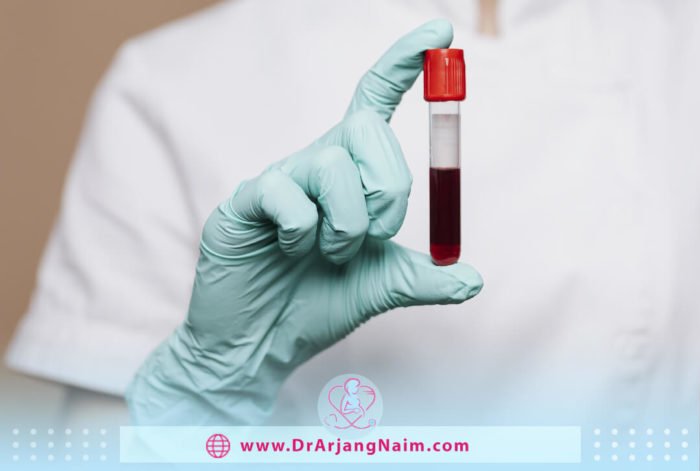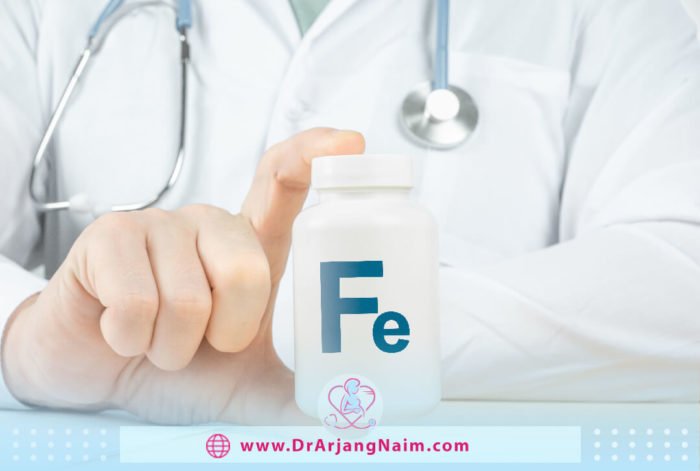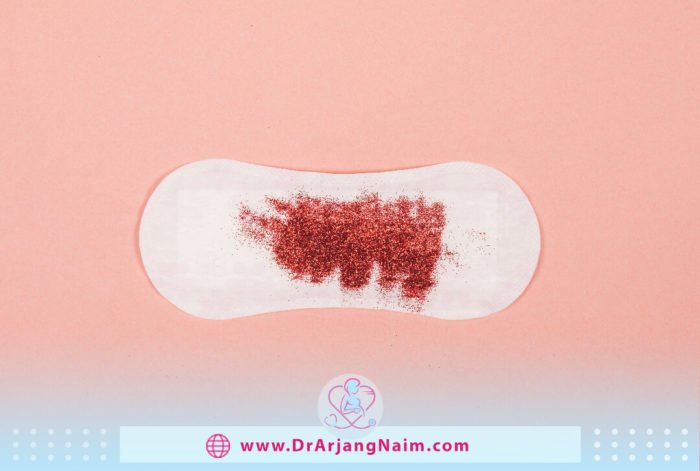Most women experience blood clots during the period at some point in their lives. Menstrual clots are gel-like spots of blood, tissue, and clotted blood that come out of the uterus during menstruation. For most women, occasional clotting in the menstrual blood is normal and not a cause for concern. However, other conditions can also cause abnormal blood clots in the menstrual blood.
Normal vs. abnormal clots
If the clots are small and only appear occasionally, there is usually no need to worry. Unlike blood clots in blood vessels, menstrual clots are not dangerous in themselves. However, the excretion of large clots during menstruation can often indicate a medical condition that needs treatment.
Natural clots are known for the following features:
- Smaller than a quarter
- Only occur occasionally, usually toward the beginning of the menstrual cycle
- Appear bright or dark red
Menstrual bleeding is considered heavy if menstrual bleeding or clots are more than a quarter of the palm and if menstrual pads need to be changed frequently every two hours or less. If there is a blood clot during pregnancy, it could indicate a miscarriage.
How menstrual clots form
Menstruation begins when hormones stimulate the body to destroy the uterus lining (endometrium). As the inner lining falls off, small blood vessels bleed. To prevent excessive blood loss, the body uses a combination of plasma and platelets to form blood clots. In menstrual blood, fragments of the lining of the uterus are mixed. Thus, what appears to be a blood clot may be a mass of endometrial cells or a mixture of endometrial cells and blood clots.
Dark red or black clots may appear in the first few days of menstruation when blood flow is heavier. Menstruation may also begin or end with bright red blood clots. This means that the blood flows fast, and there is no time to darken. For larger blood clots to pass, the cervix must dilate slightly and cause pain that can be very severe.
Potential causes
Passing blood clots during the period is often a natural occurrence on the heaviest days of the period. Most women experience a blood clot at some point in their lives. However, heavy bleeding and the passage of large clots can sometimes cause concern. Menorrhagia is menstrual bleeding that can be more severe than usual. It is uncomfortable and often painful, and many women suffer from the annoying symptoms of heavy periods.
There are many potential causes for heavy periods and abnormal menstrual blood clots in menstrual blood, and the good news is that many of the conditions and reasons for these symptoms are both common and treatable.
1.Thyroid conditions

The thyroid is a gland in the neck responsible for producing and distributing hormones. Conditions such as hypothyroidism (very low production of thyroid hormone) or hyperthyroidism (overproduction of thyroid hormone) can affect the flow and intensity of the menstrual cycle. The doctor will test the hormones T3, T4, and TSH levels to properly diagnose thyroid status.
2.Polyps and fibroids
Growths such as polyps and fibroids can settle in the uterus and its lining, making menstruation heavier and longer than usual. There are different benign fibroids, but submucosal fibroids are more likely to cause severe bleeding and large blood clots. Uterine polyps that grow on the cervix or in the uterus lining can also cause heavy clotting.
3.Birth Control
If a woman has just started a new form of contraceptive method and is expelling large blood clots during menstruation, the contraceptive method can be an influential factor. Some types of contraception, such as non-hormonal IUDs, can cause heavier-than-normal periods and clots in some women.
4.Medications
Many drugs can play a role in causing severe periods with blood clots. Anti-inflammatory drugs, hormonal drugs, and anticoagulants can play a role in abnormal menstrual flow and bleeding.
5.Miscarriage
Losing a pregnancy can happen very quickly, sometimes even before someone realizes pregnant. Early loss of a pregnancy can lead to larger blood clots than usual.
6.Endometriosis

Endometriosis is a condition in which cells that look like the uterus lining called endometrial cells to grow outside the uterus and inside the reproductive system. Their symptoms include:
- Infertility
- Pelvic pain
- Painful, crampy periods
- Nausea, vomiting, and diarrhea around the time of period
- Abnormal bleeding, which may include a blood clot
7.Adenomyosis
Adenomyosis occurs when the uterus lining grows in the uterus wall, causing the uterus to enlarge and thicken. In addition to prolonged and severe bleeding, this common complication can cause the uterus to grow two to three times its standard size.
8.Cancer
Although very rare, cancerous tumors of the uterus and cervix can lead to heavy menstrual bleeding.
9.Hormonal imbalance
Proper growth and thickening of the uterus lining depend on the balance of estrogen and progesterone. Heavy menstrual bleeding may occur if one is too much or too little.
Complications
One of the significant complications of heavy menstrual bleeding is iron deficiency anemia. Anemia is a condition in which there is insufficient iron in the blood to make healthy red blood cells. Symptoms include:
- Fatigue
- Weakness
- Paleness
- Shortness of breath
- Chest pains
Diagnosis
Blood clots are not a medical condition in themselves but a possible sign of an underlying disease. The doctor first takes the history of the patient. Then a pelvic exam and other tests are performed.
Blood tests

A blood test can check thyroid function and check for hormonal imbalances, anemia, or blood clotting problems.
Pap test
The cells are taken from the cervix and examined to determine the cause of the heavy bleeding and clots.
Ultrasound
This painless method uses sound waves to monitor blood flow and check for problems such as fibroids or endometriosis.
Endometrial biopsy
In this procedure, tissue samples are taken from the uterus lining and examined for abnormal cells.
Sonohysterogram
The doctor injects fluid into the uterus through a tube through the vagina and cervix to examine the uterus lining. During the operation, slight cramping or pressure may be felt.
Hysteroscopy
One of the best diagnostic methods, which in addition to diagnosis, is very effective in treating diseases, is hysteroscopy. Hysteroscopy is a diagnostic and therapeutic method.
Computerized tomography (CT) or magnetic resonance imaging (MRI)
While MRI uses powerful magnets and radio waves to create an image of the uterus, CT is more like an X-ray. Both methods are completely painless.
Treatment
Treatment depends on several factors, including:
- What causes a blood clot?
- How severe the clot and bleeding are
- Existence of other painful symptoms
- Age, and where you are in your reproductive journey
Iron supplements

Prolonged and severe menstrual bleeding is one of the most common causes of anemia in women of childbearing age. Anemia can cause fatigue, weakness, dizziness, and lightheadedness. The doctor may prescribe iron pills or supplements to treat this condition. Taking iron supplements does not make menstruation easier. However, it can reduce the symptoms of anemia and help replace healthy red blood cells.
Contraceptives
Some birth control pills may reduce menstrual blood flow and control irregular bleeding. Two types of oral contraceptives are used to control heavy bleeding: combined pregnancy control and progesterone-only pregnancy control. Combined contraceptive pills containing estrogen and progesterone can reduce menstrual blood flow by 77%. Another option is the hormonal IUD, which reduces menstrual blood flow by up to 95% after one year of use.
Ibuprofen
Advil or Motrin (ibuprofen) taken during menstruation can reduce pain, cramps, and bleeding by up to 49%. Advil and Motrin both fall into nonsteroidal anti-inflammatory drugs (NSAIDs). But not all NSAIDs work the same.
Hormonal therapy
Progesterone, estrogen, or a combination of the two can help reduce bleeding. These hormones can be prescribed contraceptives or doses not explicitly intended for contraception. The main difference between hormone therapy and hormonal contraceptives is that hormone therapy helps maintain fertility. Therefore, this option is preferable for women trying to conceive and control their heavy menstrual bleeding.
Surgical treatment
If polyps or fibroids need to be removed, surgical treatment is recommended. If the medication does not help or is contraindicated for any reason, the doctor may recommend surgery. Surgical options include:
- Operative hysteroscopy
- Endometrial ablation or resection
- Laparoscopy
- Myomectomy
- Hysterectomy
The bottom line
Many women experience blood clots during their reproductive years and menstruation, which often worries them. If blood clots occur during menstruation, should know that it is completely normal, but at other times, blood clot removal indicates a serious problem in the body.
If a person regularly excretes large clots, doctors may recommend many effective treatments to help control heavy bleeding and reduce clots.
Dr. Arjang Naim, MD, performs the most effective treatment by examining the patient’s condition and diagnosing the cause of blood clots during menstruation.
Additional questions
1. How many pads is normal for a period per day?
There is no right answer because there are several factors to consider that may change the number needed. A very approximate estimate is four or five pads.
2. When should you worry about spotting?
Although spotting is usually not a sign of a serious problem, it is not normal. You should see a gynecologist whenever you notice bleeding outside your period.
3. Can stress cause heavy periods?
Mental stress can cause menstrual cycles that can range from irregular periods to heavy menstrual bleeding.
4. Can fibroids pass during a period?
Uterine fibroids and treatment of fibroids can cause changes in normal vaginal discharge. Fibroid tissue can pass through, but this is rare.
5. What does period blood smell like?
Menstrual fluid, consisting of blood, unfertilized eggs, and uterine lining, may slightly odor. One may find that their period blood smells of metal due to blood and iron. The acidic environment of the vagina and the presence of different types of healthy bacteria may also play a role in the smell of vaginal discharge and menstrual blood. The normal pH of the vagina is 3.8-4.5, which is acidic. The presence of blood, semen, or urine in the vagina can affect the pH and cause various odors.
References:
https://www.healthline.com/health/womens-health/menstrual-clots
https://www.verywellhealth.com/why-are-there-blood-clots-in-my-period-2721935
https://www.medicalnewstoday.com/articles/322707
https://www.healthline.com/health/menstruation/how-often-should-you-change-your-pad




